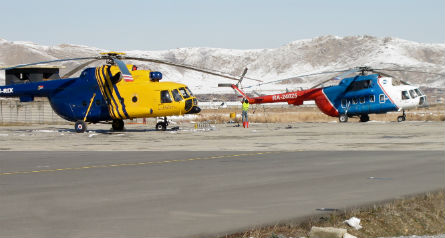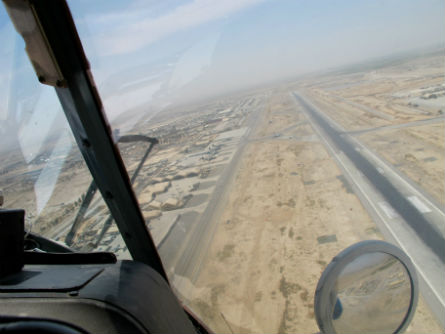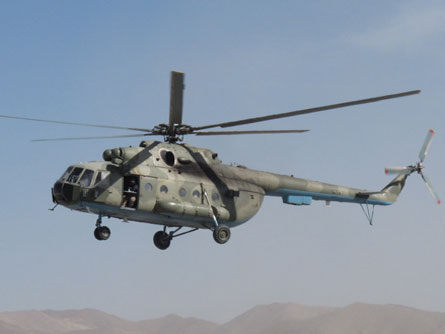By Al Venter, Kabul
Among the operational entities deployed in the war in Afghanistan, civilian transport helicopters are relatively ignored - but in ferrying men, supplies and equipment to outlying regions 365 days of the year, they provide logistical air support to the fight against the Taliban.
On any given day there are more than 100 civilian helicopters operational in the country, delivering supplies to some of the remotest outposts, staging posts, reconstruction units and military camps in Central Asia.
The majority are Russian (or in some cases former Soviet) Mil Mi-8s, but the USA has brought in Sikorsky S-61s and S-92s, Bell 214s and Eurocopter Pumas. Civilian operations involve only daytime flying; only military and Department of State Airwing helicopters, using night-vision equipment, are active at night.
Pilots based at Bagram and Kabul cite the Mi-8MTV as the real workhorse in the stable. An upgrade to the first-generation Mi-8, the MTV can carry 2,600l of fuel, which is consumed at about 700l per hour. A typical mission lasts three hours. "Depending on outside air temperatures, we can carry four tons of freight inside the helicopter; or 22 passengers with the cargo version, 28 passengers with the passenger version," says a control chief.
"We normally cruise at about 200 kilometres per hour: that allows us to fly up to 600 kilometres with a 20-minute reserve," he adds.
There is also a handful of Mi-26 helicopters in Kandahar. Depending on altitude, these can handle 90 passengers or 20 tons of freight. A couple of Kamov Ka-32s, are deployed mainly for under-slung loads that might include ammunition, fuel or water.
 |
|---|
Mi-8s on early-morning standby at Kabul airport, ready for the day's operations into remote regions |
Across the three major operational air bases in Afghanistan - Kabul, Bagram and Kandahar, the central hubs for distribution of food and other supplies - close to a dozen aviation operators are active. More than 300,000 meals - plus the aviation and vehicle fuel needed for the war effort - are flown in daily.
Among the larger players are Supreme Aviation, an airlift services provider since early 2002 supporting NATO, the United Nations and US forces; and Colombia's Vertical Aviation, which operates in support of the US Army Corps of Engineers, US Army LOGCAP IV and Office of Secretary of Defense/Counter-Narco-Terrorism Program Office. DynCorp and Evergreen also operate there.
FUNNIES
Then come what local pilots refer to as the "funnies", such as the Department of State Airwing, which has Bell 205s and UH-1s plus leased Mi-8s, and is involved in the national programme aimed at drug eradication, as well as providing regular flights for US Embassy personnel - with armed personnel on board for protection.
While not officially referred to as private military companies - though the DoS Air Wing comes close because it arms its helicopters, as a US government operation through Dyncorp - these companies are strictly civilian. Operating in an extremely hostile environment, their crews are not issued with or allowed to carry personal weapons.
Of concern to civilian air crews in Afghanistan is whether they are in a position to call on the military for assistance in the event of being shot down. "It does depend on how tied up our military aviation assets are at any one time," says a senior US officer in Kabul.
That the Taliban has been active against civilian helicopters, there is no question. With Abu Dhabi Aviation and Vertical Aviation having had helicopters shot down, civilian helicopters are now flying profiles beyond the range of small-arms fire.
However, as one major Kabul-based operator notes: "Normal routines each day involve outlying areas, so the Taliban have increased their concentration on firing on helicopters as they approach these bases... Virtually every week there are a couple of incidents where the choppers take fire and pick up holes." He adds that there have been numerous incidents involving mortaring of landing pads.
The Taliban, he explains, has neutralised vehicular movement to a significant extent. "That means that NATO forces and support organisations rely mostly on helicopters for personnel changeovers, food and equipment resupply," he says. "So the obvious tactic is to try to neutralise effective helicopter resupply by shooting down these aircraft. Effectively this tends to put something of a stranglehold on our operations."
 |
|---|
Scenes like these lead to increased demand on air transport |
To date, he says, there has been no evidence of handheld surface-to-air missiles deployed by Taliban in-theatre - however, "we expect this to change in the near future as NATO forces cannot account for all the manpads [man-portable air defence systems] that were in the Libyan inventory".
LACK OF VEGETATION
And there are fears that some of the missiles could land up in Taliban hands: "If this happens, we'd have to change our flight profiles and go in fast and low, which could place us well within the small-arms fire range."
Afghanistan's lack of vegetation or tree cover adds to the peril for helicopter operators.
Salaries for pilots range from $600 to $1,400 per day. US pilots tend to be paid more than their Eastern European counterparts - but re-supply firms might turn a blind eye to the hours flown. Some pilots fly up to 250h a month and, if a captain receives a basic of $10,000 per month and $100 per hour after the initial 70h flying time, he will notch up $30,000 per month.
The average rotation for pilots is eight weeks in and four out, though some companies do six in and six out.
Some Eastern European aviators do around three months in Afghanistan and return only if invited. The most popular helicopter among these crews is the Mi-8MTV, specially developed by the Russians for operating in Afghanistan - that is, at altitude and in unusually rugged conditions.
There are still a few older Mi-8T models operating in the country, but during summer months their performance is curtailed: on hot days, it might be limited to a meagre half-ton of freight. These machines take off at Qalat, a small posting some 80 miles to the north of Kandahar at an elevation of 5,200ft (1,580m). Here, in summer, the ambient temperature rises to the high 30os or 40os Centigrade. As pilots pull power at take-off, the coning angle on the rotors can become drastically acute, and engine revs must be pushed to the limit to prevent main rotor droop. The helicopter must then be eased over the ground, a meter at a time, until the edge of the landing zone is reached, when it is pushed down the crest to gain speed.
 |
|---|
The view from an Mi-8 on final approach to Kandahar airport |
Wages paid to armed personnel on board helicopters - as required, for example, by USAID - range from $400 to $800 a day, with a typical rotation of 12 weeks in with three weeks' leave.
But living conditions for air crews in Afghanistan can be problematic. The norm is for staff to be accommodated in secure compounds or houses within the urban boundaries of Kabul. Others are billeted in military camps in or around the capital, or at larger military bases throughout the country, so standards vary. Food on military bases is invariably good, as crews get to eat with military personnel. The downside is that they may then have only a small space in a tent where they sleep.
Under normal conditions, flying starts after first light: in summer months, this would allow for take-offs between 05:30 and 06:30. Because of the temperatures, flying is concentrated in the mornings and late afternoons.
FLIGHT HOURS
A typical day is to fly five or six hours, although pilots on food contracts might extend their operational flights to as much as 10h per day, and sometimes seven days per week. More professional outfits adhere to light duty periods and pilots are given the rest stipulated in civil aviation regulations.
Pilots are at the helicopters at least an hour before the flight for final briefing. Loading has to be strictly supervised to ensure that centre-of-gravity parameters are maintained and that weight is within take-off limits, both for altitude and temperature.
Take-off is not always an easy process, and is invariably predicated on where the individual helicopter has overnighted.
At bigger bases such as Kabul, Bagram and Kandahar, there can be a lengthy queue for machines waiting to depart. During winter months the visibility can be poor, which means that helicopters are staggered and that sometimes results in delays of 5-10min clearance time for rotorcraft and often twice that for fixed-wing aircraft.
Maintenance of helicopters is a perennial problem: each company has its own maintenance crews. For Eastern European helicopters, there are customarily two dedicated ground technicians per aircraft, and these can include Ukrainian, Kazakh, Moldavian or Tajik nationals as well as Russians. Spares for Mi-8s emanate either from Russia or Ukraine. Western operations tend to have a pool of engineers, rather than dedicate engineers for each aircraft.
One persistent problem facing civilian air operators in Afghanistan is that very little information is forthcoming from the military, particularly the US forces. A culture of non-communication with putative allies appears to be ingrained, though civilian helicopter operators often place their machines in risky situations. "We are kept in the dark with regard to potential threat factors - they allow no foreign crews to any of their briefings," says one.
 |
|---|
A Mil Mi-17 flying a support mission |
Air traffic control in Kabul is shared between civilian and military personnel under the NATO banner. And while Bagram is a military base, civilian helicopters do go there. ATC there is in the hands of US controllers.
Military and civilian security personnel man the gates to Kabul airport. At bigger airfields - such as Kandahar and Bagram - NATO troops are used for perimeter security.
All passengers embarking at the major airports have to pass through scanners and are physically searched before boarding the aircraft. If the personnel being uplifted are military, weapons have be unloaded and anybody local carrying a weapon must hand it in to the on-board security or to the pilots before take-off. The weapons are then locked in a steel box and handed back to the owner on arrival at the destination.
As for the aircrews, they are a diverse lot. Most Western aircraft are flown by English-speaking nationals, the majority of them US nationals. There are also British, Australians and South African pilots. Mi-8s are flown by Eastern Europeans, South Africans and Colombians.
The civilian helicopter complement allows the military to concentrate on operations against an increasingly efficient and resilient enemy by easing the burden of having to support bases with food, spares, ammunitions, fuel and changeovers of personnel. Even military training projects are heavily supported by civilian helicopters.
"Without the large civilian helicopter component, things might get extremely difficult," argues one long-service civilian pilot. "You only have to look at the numbers: more than 100 helicopters operational during the course of an average day, some of them multitasked and flying more than a mission a day. We're talking about thousands of tons a month that would otherwise have to be taken in by road... and we have already seen how active the Taliban has been with their ambushes, mines and IEDs [improvised explosive devices]."
Source: Flight International
















